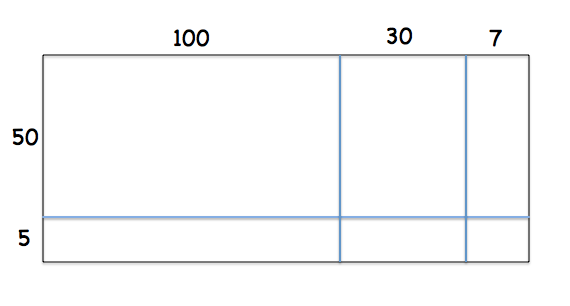A method of graphing a collection of numbers by placing the "stem" digits (or initial digits) in one column and the "leaf" digits (or remaining digits) out to the right.
What is a stem-and-leaf plot?
The number of non overlapping unit squares of a given size that will exactly cover the interior of a plan figure.
What is Area?
A type of diagram used to visualize multiplying expressions without Algebra tiles.

What is a generic rectangle?
The largest factor that two or more numbers have in common.
What is the greatest common factor?
Rita records the number of pairs of sandals owned by each of her classmates:
2, 0, 2, 2, 0, 3, 3, 2, 3, 3, 2, 1, 3, 2, 2, 2, 2, 0, 3, 2. How many dots would represent the number of people who own 3 pairs of shoes?
What is 6 people?
Find the area of the entire rectangle, labeling square centimeters as your units.
What is 27 square centimeters?
Fill in the generic rectangle.
500 1500 350
500 150 35
The factors are 1, 5, 25.
What are the factors of 25?
For an article about gas prices, Sandra researched the price of a gallon of gas in recent months. What is the most common gas price (dollars per gallon)?
What is 4 gallons?
What is the PERIMETER of the shape below? Show all your work and be sure label your units.
What is 34 inches?
Complete the generic rectangle. What number should be added to 70 along the top?
What is 5?
That is the Greatest Common Factor (GCF) of 8 and 24.
What is 8?
A graph of vertical bars representing the frequency distribution of a set of data.
What is a Histogram?
What is the AREA of the shape below? Be sure label your units.
What is 30 square inches?
This dimension is missing.
What is 20?
How can 4(3 +9) be expressed using the distributive property?
4(3) + 4(9)
A diagram that uses circles to display elements of different sets. Overlapping circles show common elements.
What is a Venn Diagram?
When labeling our measurements centimeters, meters, inches, feet, yards, ect are used.

What are units of measurement?
This multiplication problem represented in this generic rectangle.
How can 5(3 +2) be expressed using the distributive property?
5(3) + 5(2)







